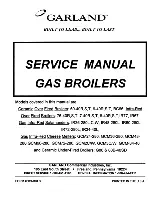
TURBOMAX Use and Care Manual with Installation Instructions July 2014 Page
14
Pressure loss from water flow in pipe fittings
and valves
In addition to the pressure loss in straight pipe,
there will be pressure losses from turbulence
and change of direction through fittings and
valves. These pressure losses are shown in
Table 3.
The pressure losses are expressed in Table 3
in a way that is called the “equivalent length”.
The listings for a particular fitting of a given size
show the “equivalent length” (E.L.) of straight
pipe that would have the same pressure drop.
After finding the “equivalent length” (E.L.) from
Table 3, the appropriate friction loss table (Table
1 or Table 2) is used to find the actual pressure
drop through the fitting.
Example 3: What is the pressure loss through a
1-1/2 inch 90° copper standard elbow in a piping
system through which 25 GPM of water is
flowing.
Answer: from Table 3 find the equivalent length
of the fitting = 4.5 feet. From Table 1 find the
pressure loss for a 1-1/2 inch copper tube,
through which 25 GPM of water is flowing
= 5.46 feet of water per 100 feet. The pressure
loss through the fitting is 4.5% (= 4.5 feet E.L./
100 feet) of a straight 1-1/2 inch diameter copper
tube. The calculated result is 0.25 feet of water
(= 4.5% of 5.46 feet of water)
Pressure loss from water flow in TURBOMAX
tank.
There will be pressure losses from turbulence
and change of direction through TURBOMAX
tank. These pressure losses are shown in
Table 4. The pressure losses through the boiler
water’s side (or tank‘s side) are expressed in
feet of water. The pressure losses, through the
domestic water’s side (or copper coil system’s
side) are expressed in p.s.i..
Example 4: What is the pressure loss of boiler
water flowing through a TURBOMAX
®
#109 at 60
GPM? Answer: the pressure loss is 2 feet of
water.
Pressure loss from boiler or other equipment
Information on pressure drops (losses) through a
boiler or other equipment is obtained from the
manufacturer.
Piping system pressure drop calculation.
The pressure loss from friction in a closed piping
system is required to determine the required
pump head. The system pressure drop is simply
the sum of the losses through each item in one
circuit from pump discharge to pump suction,
including piping, fittings, valves, TURBOMAX
®
tank, boiler and other equipment.
To find the system pressure drop, therefore:
First inspect the piping layout.
Second, note all the elements through which
pressure loss occurs in the circuit from pump
discharge to pump suction. Write down the size
of the fitting.
Third, measure pipe length and note the pipe
diameter and material of the circuit.
Fourth, calculate for each element (pipes,
fittings, valves, TURBOMAX tank, boiler and
other equipment) the pressure loss at the boiler
water flow rate calculated earlier.
It should be taken into consideration that, as the
piping system ages, friction losses increase. It is
recommended that for most commercial design
purposes a safety factor of 15 to 20 % be added
to the values in Tables 1 and 2.
Fifth, sum all the pressure losses of each item in
the circuit
Pump or circulator selection
Consult pump manufacturer’s pump curves to
select the proper pump model. Performance
characteristics of centrifugal pumps are
described by pump curves, which plot flow
versus head or pressure together with other
information such as efficiency and power.
To select the proper pump that fits your needs,
ask your pump dealer or your HVAC wholesaler
for a recommendation.
Содержание VOLTMAX 23
Страница 9: ...TURBOMAX Use and Care Manual with Installation Instructions July 2014 Page 9 ...
Страница 10: ...TURBOMAX Use and Care Manual with Installation Instructions July 2014 Page 10 ...
Страница 17: ...TURBOMAX Use and Care Manual with Installation Instructions July 2014 Page 17 ...
Страница 20: ...TURBOMAX Use and Care Manual with Installation Instructions July 2014 Page 20 ...
Страница 23: ...TURBOMAX Use and Care Manual with Installation Instructions July 2014 Page 23 ...















































